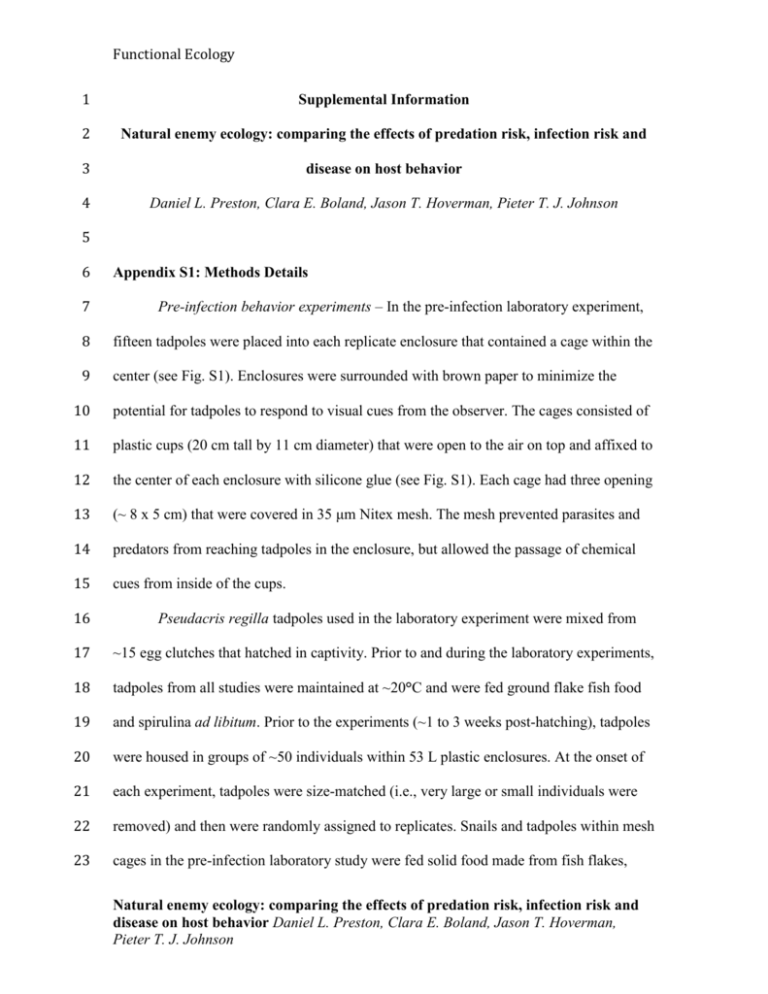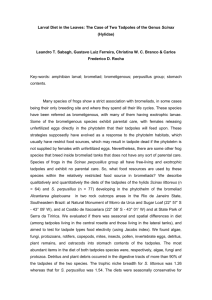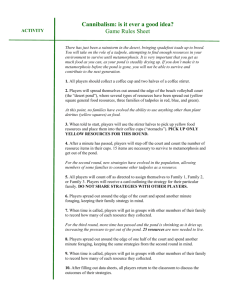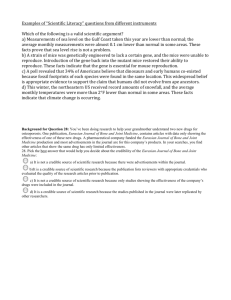fec12293-sup-0002-AppendixS1
advertisement

Functional Ecology 1 Supplemental Information 2 Natural enemy ecology: comparing the effects of predation risk, infection risk and 3 disease on host behavior 4 Daniel L. Preston, Clara E. Boland, Jason T. Hoverman, Pieter T. J. Johnson 5 6 7 Appendix S1: Methods Details Pre-infection behavior experiments – In the pre-infection laboratory experiment, 8 fifteen tadpoles were placed into each replicate enclosure that contained a cage within the 9 center (see Fig. S1). Enclosures were surrounded with brown paper to minimize the 10 potential for tadpoles to respond to visual cues from the observer. The cages consisted of 11 plastic cups (20 cm tall by 11 cm diameter) that were open to the air on top and affixed to 12 the center of each enclosure with silicone glue (see Fig. S1). Each cage had three opening 13 (~ 8 x 5 cm) that were covered in 35 μm Nitex mesh. The mesh prevented parasites and 14 predators from reaching tadpoles in the enclosure, but allowed the passage of chemical 15 cues from inside of the cups. 16 Pseudacris regilla tadpoles used in the laboratory experiment were mixed from 17 ~15 egg clutches that hatched in captivity. Prior to and during the laboratory experiments, 18 tadpoles from all studies were maintained at ~20°C and were fed ground flake fish food 19 and spirulina ad libitum. Prior to the experiments (~1 to 3 weeks post-hatching), tadpoles 20 were housed in groups of ~50 individuals within 53 L plastic enclosures. At the onset of 21 each experiment, tadpoles were size-matched (i.e., very large or small individuals were 22 removed) and then were randomly assigned to replicates. Snails and tadpoles within mesh 23 cages in the pre-infection laboratory study were fed solid food made from fish flakes, Natural enemy ecology: comparing the effects of predation risk, infection risk and disease on host behavior Daniel L. Preston, Clara E. Boland, Jason T. Hoverman, Pieter T. J. Johnson Functional Ecology 24 spirulina and agar. Equal amounts of food were placed in the control and dragonfly cages 25 to account for chemical cues coming from food within cages. The tubs were arrayed in a 26 randomized block design and we rotated their position and conducted water changes 27 approximately every third day. 28 Mesocosm methods – The mesocosms consisted of 378 L livestock watering tanks 29 that were filled with well water and 6 kg of silica sand as substrate (Fig. S2). We covered 30 the mesocosms with mesh screen lids (1.5 mm) to prevent unintended colonization by 31 insects. On May 16th, we added 30 g of rabbit chow and 250 mL of periphyton suspended 32 in natural pond water as a source of nutrients and algae inoculum, respectively. 33 Periphyton was collected by shaking aquatic plants into a bucket of pond water. Between 34 May 18th and May 31st we added a total of 750 mL of concentrated zooplankton from a 35 local wetland (primarily calanoid copepods and cladocerans). On June 3rd and June 4th we 36 introduced 15 P. regilla tadpoles and 15 A. boreas tadpoles that had been previously 37 collected as embryos in Mendocino County, California. As with the laboratory studies, 38 tadpoles were mixed from multiple egg masses. Prior to the start of the experiment, 39 tadpoles were maintained in the laboratory as described above. 40 The cages used in the mesocosm experiment consisted of plastic 16 oz cups that 41 were allowed to float freely on surface of the water. The cups were 12 cm tall by 9 cm 42 wide at the top. We affixed a piece of 35 μm Nitex mesh to the opening of each cup using 43 a secure rubber band (no holes were made in the cups, in contrast to the cages in the 44 laboratory experiment). This allowed us to access the cages to check on the dragonflies, 45 snails and tadpoles that were held within. The cages naturally floated upside down within 46 the mesocosms (i.e., the mesh was facing down into the tank allowing the passage of Natural enemy ecology: comparing the effects of predation risk, infection risk and disease on host behavior Daniel L. Preston, Clara E. Boland, Jason T. Hoverman, Pieter T. J. Johnson Functional Ecology 47 chemical cues). Into each cage we also placed a 10 cm length of periphyton-covered 48 cattail stem (Typha sp.) that provided a food source to snails and tadpoles and perching 49 surface for dragonfly larvae. The cages were checked every other day throughout the 50 experiment and deceased tadpoles were replaced as necessary. 51 Pre-infection response variable measurement – The behavioral observations for 52 the pre-infection experiments were conducted at one time each day, beginning at 08:00 53 hrs in the laboratory study and at 12:00 hrs in the mesocosm study. Each replicate was 54 observed five times per day in the laboratory study and fifteen times per day in the 55 mesocosm study. In both experiments, the order of observations was reversed between 56 consecutive rounds (i.e., the first replicate observed became the last replicate observed on 57 the subsequent observation round; this approach aimed to remove potential effects of 58 observation time). Observing each replicate took approximately 5 seconds in the 59 laboratory experiment and 15 seconds in the mesocosm experiment. Changes in 60 movement status within the observation period did not affect the final count of active 61 tadpoles because each tadpole was counted at only one specific time within each 62 observation period and therefore could only be moving or not moving. 63 Post-infection behavior experiments – For three of the four post-infection 64 experiments, individual Pseudacris regilla tadpoles were maintained in containers with 65 750 mL of water and fed as described above. Tadpoles were infected with trematodes by 66 isolating cercariae from field-collected infected snails within 50 mL vials. Cercariae were 67 removed from the 50 mL vials using a glass pipet, counted under a dissecting 68 microscope, and administered to individually housed tadpoles according to the dosage of 69 each treatment. Tadpoles in treatments that were not infected received a sham dosage of Natural enemy ecology: comparing the effects of predation risk, infection risk and disease on host behavior Daniel L. Preston, Clara E. Boland, Jason T. Hoverman, Pieter T. J. Johnson Functional Ecology 70 water that did not contain cercariae. Because cercariae are short lived (< 24 hrs) and the 71 peak time of trematode emergence from snails varies between the species used, we 72 conducted infections at 14:00 hrs for Echinostoma and Alaria and at 23:00 hrs for 73 Ribeiroia (see also Johnson & Hartson 2009 and Johnson, Kellermanns & Bowerman 74 2011 for exposure protocols). 75 The response data collected on tadpoles in three of the four experiments consisted 76 of observations of tadpole activity levels (yes/no data based on whether each individual 77 was moving or not). Each replicate was observed one after another until every replicate 78 had been observed 30 times (as opposed to observing each replicate 30 times in a row and 79 then moving on to the next replicate). The order of observations was reversed between 80 consecutive rounds (i.e., the first replicate observed became the last replicate observed on 81 the subsequent observation round). Each observation on the single tadpole per replicate 82 was instantaneous (< 1 second), so the total amount of time elapsed between observations 83 on the same tadpole varied with the number of replicates in the experiment (from 40 84 tadpoles in experiments one and four to 70 tadpoles in experiment three). We estimated 85 that the amount of time between observations on the same tadpole ranged from two to 86 four minutes for the three experiments. 87 In the escape distance experiment, the track was made of white PVC plastic. It 88 held approximately 2 L of water and the water was not changed between trials. A tape 89 with markings every one cm was affixed to the laboratory bench along the length of the 90 track. The final position of each tadpole in the track was determined visually and was 91 recorded in a laboratory notebook after each trial run. Natural enemy ecology: comparing the effects of predation risk, infection risk and disease on host behavior Daniel L. Preston, Clara E. Boland, Jason T. Hoverman, Pieter T. J. Johnson Functional Ecology 92 Analyses – For the pre-infection experiments, we initially determined that there 93 were no significant differences in the number of active tadpoles across treatments prior to 94 the introduction of chemical cues and therefore focused our analysis on the data from 95 after the introduction of chemical cues (days three through ten in both the mesocosm and 96 laboratory experiments). Our GLMMs included a fixed effect of treatment and random 97 effects of observation date and of experimental unit (plastic tub or mesocosm). The 98 random effect of experimental unit accounted for non-independence of multiple 99 observations made on each replicate (i.e., five observations per day in the laboratory 100 study and 15 observations per day in the mesocosm study). The random effect of date 101 accounted for correlated daily variation in activity levels due to environmental conditions 102 (e.g., temperature). We analyzed the data on the number of tadpoles at the surface of the 103 water from the laboratory study in the same manner as tadpole activity. 104 In all post-infection analyses we specified individual tadpole host as a random 105 effect to account for non-independence of multiple observations made on the same 106 tadpole on the same date. All of the details for the analyses of the first three experiments 107 are provided in the main text. For the fourth experiment, in which we varied tadpole size 108 and development stage, we detected significant differences in tadpole activity levels one 109 day prior to exposure because small tadpoles were less active than larger individuals. To 110 account for this pre-existing difference, we created a model with a fixed effect of tadpole 111 size (snout-vent length), a fixed effect of experimental period (before or after exposure) 112 and an interaction between tadpole size and experimental period. If tadpole size mediated 113 the magnitude of behavioral responses to infection we expected to see an interaction Natural enemy ecology: comparing the effects of predation risk, infection risk and disease on host behavior Daniel L. Preston, Clara E. Boland, Jason T. Hoverman, Pieter T. J. Johnson Functional Ecology 114 between experimental period and snout-vent length, where the effect of snout-vent length 115 differed from pre- to post Ribeiroia exposure (see Results in the main text). 116 The analyses presented in the main text for the post-infection experiments used 117 parasite dosage as a predictor variable. Because we necropsied all of the amphibians at 118 the end of the experiments, we were also able to examine whether using infection 119 intensity (i.e., the number of successful cysts per host) altered any of our conclusions 120 from the two studies in which we varied parasite dosage. We found that infection 121 intensity closely mirrored the parasite dosages administered in both the dosage and 122 recovery experiment (r2 = 0.88) and the escape distance experiment (r2 = 0.82). In the 123 dosage experiment, the number of successfully encysting parasites at the conclusion of 124 the study was a negative predictor of host activity one day after exposure (GLMM, z = - 125 2.997, p = 0.002). Similarly, infection intensity was also a strong negative predictor of 126 distance travelled in the escape distance experiment (GLMM, z = -7.241, p < 0.001). 127 128 References 129 Johnson, P.T.J. & Hartson, R.B. (2009) All hosts are not equal: explaining differential 130 patterns of malformations in an amphibian community. Journal of Animal 131 Ecology, 78, 191–201. 132 Johnson, P.T.J., Kellermanns, E. & Bowerman, J. (2011) Critical windows of 133 disease risk: amphibian pathology driven by developmental changes in host 134 resistance and tolerance. Functional Ecology, 25, 726–734. 135 136 Natural enemy ecology: comparing the effects of predation risk, infection risk and disease on host behavior Daniel L. Preston, Clara E. Boland, Jason T. Hoverman, Pieter T. J. Johnson Functional Ecology Experiment Pseudacris regilla Anaxyrus boreas snout-vent length, mm (SE) snout-vent length, mm (SE) Laboratory 7.7 (.07) - Mesocosm 10.2 (0.06) 12.9 (0.13) Multiple trematodes 5.6 (0.08) - Dosage and recovery 8.4 (0.09) - Escape distance 4.3 (0.05) - Tadpole size see Fig. 3b - Pre-infection Post-infection 137 138 Table S1. Mean snout-vent lengths of amphibian larvae used in all experiments. 139 Amphibians were measured at the conclusion of each study. 140 141 142 143 Natural enemy ecology: comparing the effects of predation risk, infection risk and disease on host behavior Daniel L. Preston, Clara E. Boland, Jason T. Hoverman, Pieter T. J. Johnson Functional Ecology 144 145 Figure S1. Replicate enclosures in the pre-infection laboratory experiment. Each cup has 146 openings covered in mesh that emit chemical cues into the surrounding water while also 147 preventing natural enemies from reaching tadpoles in the enclosures. Photo by Dan 148 Preston. 149 150 151 152 153 154 155 156 157 158 Natural enemy ecology: comparing the effects of predation risk, infection risk and disease on host behavior Daniel L. Preston, Clara E. Boland, Jason T. Hoverman, Pieter T. J. Johnson Functional Ecology 159 160 Figure S2. Outdoor mesocosms at the Hopland Research and Extension Center in 161 Mendocino County, California that were used to examine the effects of chemical cues 162 from predators and parasites on amphibian behavior. Photo by Dan Preston. Natural enemy ecology: comparing the effects of predation risk, infection risk and disease on host behavior Daniel L. Preston, Clara E. Boland, Jason T. Hoverman, Pieter T. J. Johnson











